Pentium 4 3.46 Extreme Edition and 925XE: 1066MHz FSB Support is Here
by Anand Lal Shimpi on October 31, 2004 3:00 PM EST- Posted in
- CPUs
Workstation Applications
Visual Studio 6
Carried over from our previous CPU reviews, we continue to use Visual Studio 6 for a quick compile test. We are still using the Quake 3 source code as our test and measure compile time in seconds. The results are pretty much in line with what we've seen in the past.
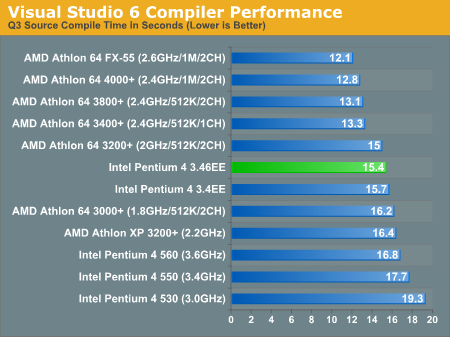
SPECviewperf 8
For our next set of professional application benchmarks we turn to SPECviewperf 8. SPECviewperf is a collection of application traces taken from some of the most popular professional applications, and compiled together in a single set of benchmarks used to estimate performance in the various applications the benchmark is used to model. With version 8, SPEC has significantly improved the quality of the benchmark, making it even more of a real world indicator of performance.
We have included SPEC's official description of each one of the 8 tests in the suite.
3dsmax Viewset (3dsmax-03)
"The 3dsmax-03 viewset was created from traces of the graphics workload generated by 3ds max 3.1. To insure a common comparison point, the OpenGL plug-in driver from Discreet was used during tracing.
The models for this viewset came from the SPECapc 3ds max 3.1 benchmark. Each model was measured with two different lighting models to reflect a range of potential 3ds max users. The high-complexity model uses five to seven positional lights as defined by the SPECapc benchmark and reflects how a high-end user would work with 3ds max. The medium-complexity lighting models uses two positional lights, a more common lighting environment.
The viewset is based on a trace of the running application and includes all the state changes found during normal 3ds max operation. Immediate-mode OpenGL calls are used to transfer data to the graphics subsystem."
The biggest surprise here is that there is a huge performance impact (13%) by moving down to a single channel memory subsystem with the Athlon 64. There are also a couple of other surprises, with the Pentium 4 560 doing surprisingly well, coming in at the heels of the Athlon 64 FX-55.
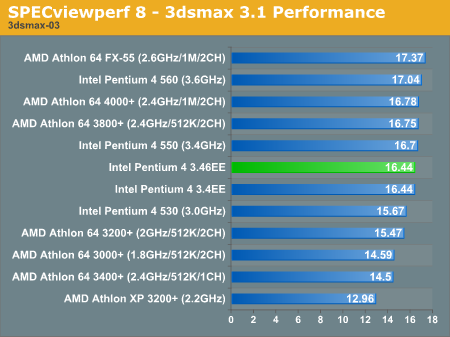
CATIA Viewset (catia-01)
"The catia-01 viewset was created from traces of the graphics workload generated by the CATIATM V5R12 application from Dassault Systems.
Three models are measured using various modes in CATIA. Phil Harris of LionHeart Solutions, developer of CATBench2003, supplied SPEC/GPC with the models used to measure the CATIA application. The models are courtesy of CATBench2003 and CATIA Community.The car model contains more than two million points. SPECviewperf replicates the geometry represented by the smaller engine block and submarine models to increase complexity and decrease frame rates. After replication, these models contain 1.2 million vertices (engine block) and 1.8 million vertices (submarine).
State changes as made by the application are included throughout the rendering of the model, including matrix, material, light and line-stipple changes. All state changes are derived from a trace of the running application. The state changes put considerably more stress on graphics subsystems than the simple geometry dumps found in older SPECviewperf viewsets.
Mirroring the application, draw arrays are used for some tests and immediate mode used for others."

Lightscape Viewset (light-07)
"The light-07 viewset was created from traces of the graphics workload generated by the Lightscape Visualization System from Discreet Logic. Lightscape combines proprietary radiosity algorithms with a physically based lighting interface.
The most significant feature of Lightscape is its ability to accurately simulate global illumination effects by precalculating the diffuse energy distribution in an environment and storing the lighting distribution as part of the 3D model. The resulting lighting "mesh" can then be rapidly displayed."

Maya Viewset (maya-01)
"The maya-01 viewset was created from traces of the graphics workload generated by the Maya V5 application from Alias.
The models used in the tests were contributed by artists at NVIDIA. Various modes in the Maya application are measured.
State changes as made by the application are included throughout the rendering of the model, including matrix, material, light and line-stipple changes. All state changes are derived from a trace of the running application. The state changes put considerably more stress on graphics subsystems than the simple geometry dumps found in older viewsets.
As in the Maya V5 application, array element is used to transfer data through the OpenGL API."
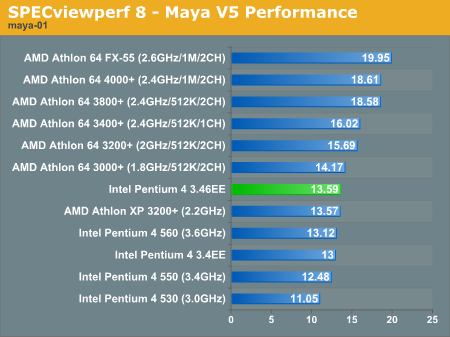
Pro/ENGINEER (proe-03)
"The proe-03 viewset was created from traces of the graphics workload generated by the Pro/ENGINEER 2001TM application from PTC.
Two models and three rendering modes are measured during the test. PTC contributed the models to SPEC for use in measurement of the Pro/ENGINEER application. The first of the models, the PTC World Car, represents a large-model workload composed of 3.9 to 5.9 million vertices. This model is measured in shaded, hidden-line removal, and wireframe modes. The wireframe workloads are measured both in normal and antialiased mode. The second model is a copier. It is a medium-sized model made up of 485,000 to 1.6 million vertices. Shaded and hidden-line-removal modes were measured for this model.
This viewset includes state changes as made by the application throughout the rendering of the model, including matrix, material, light and line-stipple changes. The PTC World Car shaded frames include more than 100MB of state and vertex information per frame. All state changes are derived from a trace of the running application. The state changes put considerably more stress on graphics subsystems than the simple geometry dumps found in older viewsets.
Mirroring the application, draw arrays are used for the shaded tests and immediate mode is used for the wireframe. The gradient background used by the Pro/E application is also included to better model the application workload."
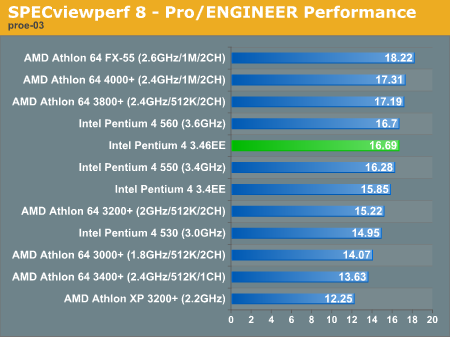
SolidWorks Viewset (sw-01)
"The sw-01 viewset was created from traces of the graphics workload generated by the Solidworks 2004 application from Dassault Systemes.
The model and workloads used were contributed by Solidworks as part of the SPECapc for SolidWorks 2004 benchmark.
State changes as made by the application are included throughout the rendering of the model, including matrix, material, light and line-stipple changes. All state changes are derived from a trace of the running application. The state changes put considerably more stress on graphics subsystems than the simple geometry dumps found in older viewsets.
Mirroring the application, draw arrays are used for some tests and immediate mode used for others."
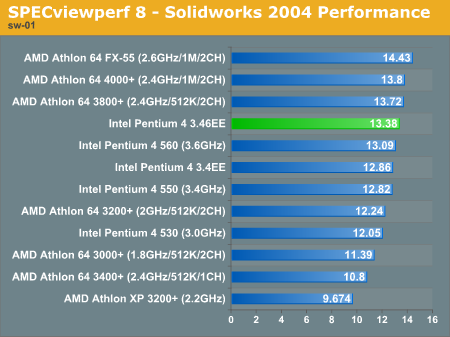
Unigraphics (ugs-04)
"The ugs-04 viewset was created from traces of the graphics workload generated by Unigraphics V17.
The engine model used was taken from the SPECapc for Unigraphics V17 application benchmark. Three rendering modes are measured -- shaded, shaded with transparency, and wireframe. The wireframe workloads are measured both in normal and anti-alised mode. All tests are repeated twice, rotating once in the center of the screen and then moving about the frame to measure clipping performance.
The viewset is based on a trace of the running application and includes all the state changes found during normal Unigraphics operation. As with the application, OpenGL display lists are used to transfer data to the graphics subsystem. Thousands of display lists of varying sizes go into generating each frame of the model.
To increase model size and complexity, SPECviewperf 8.0 replicates the model two times more than the previous ugs-03 test."











63 Comments
View All Comments
T8000 - Thursday, November 4, 2004 - link
The most important part of this release is the Intel 925XE chipset, that will allow much higher overclocks because of its 1066 bus support.This is because the 925XE will have the right divider to reach 1066 without any PCI-E overclock.
So with a 925XE mainboard, you can run an Intel 530 CPU at 4Ghz with any PCI-E GPU you choose, because only the CPU will be overclocked and Prescott has excellent chances of reaching 4Ghz with modest water cooling or good air cooling.
Odeen - Wednesday, November 3, 2004 - link
Realtek codec on an Intel board... and here I thought Intel actually made quality motherboards, which entails Sigmatel or Soundmax onboard audio chips.Sigh :(
johnsonx - Wednesday, November 3, 2004 - link
Slim: You're right... my bad. I didn't read every single page. I read the couple of introductory pages, then skipped to the test configuration page, perused a few benches, and then skipped to the conclusion.The measured results of course are no different than I thought they would be...
bob661 - Tuesday, November 2, 2004 - link
We need to have our own review website called www.dontreleasesh!tunlessitsactuallyabetterproductthan theonebeforeit.com.SLIM - Tuesday, November 2, 2004 - link
johnsonx,Anand did isolate the fsb as the sole variable when he DOWNclocked both chips to 3.2ghz (266 x 12 and 200 x 16) on page 3. There was a slight caveat that faster chips would benefit more from a fsb boost. And yes the faster bus increased performance by almost 1% in some tests woohoo!!!
SLIM
johnsonx - Tuesday, November 2, 2004 - link
One thing that might've been interesting to see:Overclock the 3.4EE to 3.46Ghz by OC'ing the FSB to 203Mhz or 204Mhz (812 & 816 respectively). This would completely isolate the effect if the increased clock speed of the 3.46EE, showing only the increased FSB performance... at that point I suspect that the tiny performance gains would completely evaporate.
Mind you, I'm not suggesting this would change the conclusion much, but it would put a big exclamation point to it...
BTW, one does have to wonder why Intel bothered with this. If the 3.46EE/925XE combo is no faster than the 3.4EE/925X combo (I'm assuming the 925X=925XE @800FSB), then why go through all the trouble? Indeed, isn't it true that an 'old' 3.4EE/875 combo is faster still?
Good grief, at least when AMD releases a new top-end chip it is actually measurably faster. Regardless of whether the rating is 'earned' or not, no one can argue that the 4000 isn't (generally) faster than the 3800, nor that the FX-55 isn't faster than any other A64.
Tides - Tuesday, November 2, 2004 - link
Some benchmarks? Hardly. AMD owns in actual games, workstation apps, and half of the other stuff. Not to mention AMD doesn't make you upgrade to ddr2, and AMD cpus are 64bit. Intel's new chips have low shelf lives while the current AMD 64's you buy will last you a lot longer.Performance, realiability, and long lasting.
danidentity - Tuesday, November 2, 2004 - link
IntelUser2000, you couldn't possibly be any more wrong. I will be the first to admit that AMD chips excel above Intel chips in many benchmarks.However:
1. Intel is no where near dead. Calling them so is ridiculous. In Q3 of this year Intel posted revenue of 8.5 billion compared to AMD's 1.2 billion, or SEVEN times as much.
2. AMD is NOT closing "very rapidly" in marketshare. It would appear that way from reading sites and forums like these, but it gives you a false impression. Keep in mind that the largest supplier of PCs on the planet puts Intel chips in every machine. AMD's mobile chips can't compete with the Pentium M in terms of performance and functionality.
3. Intel is not stupid, they have some of the best engineers on the planet. If they seriously thought that AMD was going to topple them as the market leader, or even if they are predicting it, you can GUARANTEE they have something in the works to strike back. They have the means and the money.
4. While many people don't know exactly what clockspeed is, everyone thinks it is the ultimate measure of performance. That mindset will take a LONG time to change, and by then, Intel will have something new.
Most people out there don't even know AMD exists. Just because AMD chips beat Intel chips in some benchmarks posted on technical computer sites, don't mean they're going to topple Intel.
JonahStone - Tuesday, November 2, 2004 - link
Performance is not the only reason why somebody buys a CPU. Although 64 bit might not be available now, does not make it unimportant. Many who buy a computer will keep it for a long time. I do not want to buy a new PC in a year's time to run 64 bit apps. All reviews keep on comparing 32 bit performance and do not even mention the advantage 64 bit will bring. It does matter!!!!!!!IntelUser2000 - Monday, November 1, 2004 - link
Intel is not doing bad. They are doing terrible. So terrible that you might as well call them dead. Probably will last till 2009 before they fill bankruptcy.To those people who say people in forums don't know anything and that there are other people stupid enough to buy Intel chips(I mean all Intel chips): Uhh, yeah, get your head straight, since AMD is closing with Intel very rapidly in marketshare, in server, desktop, and laptop, and that means that gamers actually do make a difference(albeit slowly) making other people buy computers. You think other people will buy P4's because of high clock speed? That's BS, since people who is stupid enough to buy Intel chips don't even know what clock speeds does. There are only a very few that knows computers JUST enough to say clock speed is good.